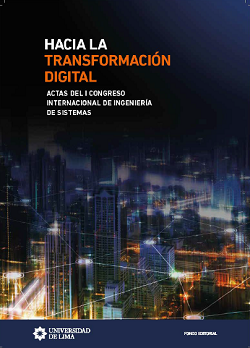Algoritmo genético con tecnología Blockchain para reducir la entropía de una cadena de suministro
DOI:
https://doi.org/10.26439/ciis2018.5348Palabras clave:
Algoritmos genéticos, Cadena de suministro, BlockchainsResumen
La presente investigación desarrolla un algoritmo genético combinado con tecnología Blockchain para gestionar transacciones en una cadena de suministro reduciendo la entropía de la misma. La investigación utiliza un algoritmo genético para gestionar transacciones encriptadas usando el algoritmo sha256, y distribuirlas usando Blockchain para el flujo de gestión de las cadenas de suministros con componentes incrementales midiendo la entropía de Shannon de la cadena en Python 3.5 mediante técnicas de simulación. La investigación muestra cómo el uso de la programación genética combinada con tecnología Blockchain permite reducir la entropía de la cadena de suministro reduciendo con ello los costos y tiempos de transacción e incrementando los niveles de seguridad y confiabilidad en el proceso transaccional de toda la cadena.
Descargas
Referencias
AbuKhousa, E., Al-Jaroodi, J., Lazarova-Molnar, S., y Nader, M. (2014). Simulation and modeling efforts to support decision making in healthcare supply chain management. The Scientific World Journal. DOI:10.1155/2014/354246
Al-Mutawah, K., Lee, V., y Cheung, Y. (2009). A new multi-agent system framework for tacit knowledge management in manufacturing supply chains. Journal of Intelligent Manufacturing 20(5), 593-610. DOI:10.1007/s10845-008-0142-0
Al-Odeh, M. (2016). Supply chain information systems technologies and management strategies in northern minnesota. Journal of Supply Chain Management Systems 5(2).
Badenhorst, J. A., Maurer, C., y Brevis-Landsberg, T. (2013). Developing measures for the evaluation of information flow efficiency in supply chains. Journal of Transport and Supply Chain Management 7(1). DOI:10.4102/jtscm.v7i1.88
Blome, C., Schoenherr, T., y Eckstein, D. (2014). The impact of knowledge transfer and complexity on supply chain flexibility: A knowledge-based view. International Journal of Production Economics 147, pp. 307-316. DOI:10.1016/j.ijpe.2013.02.028
Candaci, Y. Y., Ngai, E. W. T. y Moon, K.-L. (2011). Supply chain flexibility in an uncertain environment: exploratory findings from five case studies. Supply Chain Management: An International Journal 16(4), pp. 271-283.
Coppens, D. (2013). How special is the special and differential treatment under the SCM agreement? A legal and normative analysis of WTO subsidy disciplines on developing countries. World Trade Review 12(1), 79-109. DOI:10.1017/S1474745612000493
Fantazy, K. A., Kumar, V. y Kumar, U. (2009). An empirical study of the relationships among strategy, flexibility and performance in the supply chain context. Supply Chain Management: An International Journal 14(3), pp. 177-188.
Gerschberger, M., Engelhardt-Nowitzki, C., Kummer, S., y Staberhofer, F. (2012). A model to determine complexity in supply networks. Journal of Manufacturing Technology Management 23(8), 1015-1037. DOI:10.1108/17410381211276853
González-R. P. L., Framinan, J. M., y Ruiz-Usano, R. (2013). A methodology for the design and operation of pull-based supply chains. Journal of Manufacturing Technology Management 24(3), 307-330. DOI:10.1108/17410381311318855
Holland, J. H. (1975). Adaptation in natural and artificial systems: an introductory analysis with applications to biology, control, and artificial intelligence. Boston: MIT Press.
Horvath, L. (2001). Collaboration: The key to value creation in supply chain management. Supply Chain Management 6(5), 205-207.
Huang, Y., Yang, M., y Wong, Y. (2016). Institutional pressures, resources commitment, and returns management. Supply Chain Management 21(3), 398-416.
Isik (2009). An entropy based approach for measuring complexity in supply chains. International Journal of Production Research, 48(12), 3681-3696.
Ivanov, D., Sokolov, B., y Kaeschel, J. (2011). Integrated supply chain planning based on a combined application of operations research and optimal control. Central European Journal of Operations Research 19(3), 299-317. DOI:10.1007/s10100-010-0185-0
Kahraman, C., Kaya, I., y Cevikcan, E. (2011). Intelligence decision systems in enterprise information management. Journal of Enterprise Information Management 24(4), pp. 360-379. DOI:10.1108/17410391111148594
Kim, K., Kim, T., Lim, D., y Park, H. M. (2013). Managing the supply and demand uncertainty in workforce recruitment: Planned or just-in-time acquisition. The Journal of the Operational Research Society 64(11), 1654-1663. DOI:10.1057/jors.2012.152
Kim, S. W. (2006). Effects of supply chain management practices, integration and competition capability on performance. Supply Chain Management 11(3), pp. 241-248. DOI:10.1108/13598540610662149
Lin, C., Hung, H. C., Wu, J. Y., y Lin, B. (2002). A knowledge management architecture in collaborative supply chain. Journal of Computer Information Systems 42(5), pp. 83-94. DOI:10.1080/08874417.2002.11647612
Minculete, G., y Olar, P. (2016). “Push” and “Pull” systems in supply chain management. correlative approaches in the military field. Journal of Defense Resources Management 7(2), 165-172.
Nowiński, W., y Kozma, M. (2017). How can blockchain technology disrupt the existing business models? Entrepreneurial Business and Economics Review 5(3), 173-188. DOI:10.15678/EBER.2017.050309
Olatunde, A. D., Chan, H. K., y Wang, X. (2012). Entropy assessment of supply chain disruption. Journal of Manufacturing Technology Management 23(8), pp. 998-1014. DOI:10.1108/17410381211276844
Schwarz-Díaz, M. G. (2014). Una medida de la incertidumbre basada en la entropía para cuantificar el impacto de la pérdida de información de los sistemas de gestión. Paideia XXI 4(5), pp. 46-56.
Shannon, C. E. (1948). A mathematical theory of communication. The Bell System Technical Journal, 27(3).
Tan, K., y Cross, J. (2012). Influence of resource-based capability and inter-organizational coordination on SCM. Industrial Management & Data Systems 112(6), pp. 929-945. DOI:10.1108/02635571211238527
Yahia, Z. M. (2009). The collaborative supply chain. Assembly Automation 29(2), pp. 127-136. DOI:10.1108/01445150910945589
Wever, M., Wognum, P. M., Trienekens, J. H., y Omta, S. W. F. (2012). Supply chain-wide consequences of transaction risks and their contractual solutions: towards an extended transaction cost economics framework. Journal of Supply Chain Management 48(1), pp. 73-91.
Williams, A.J. (2014). Transporting tacit supply knowledge in competitive environments: a storytelling perspective. International Journal of Procurement Management 7(5), pp. 622-638. DOI:10.1504/IJPM.2014.064622
Woodside, J. M., Augustine Jr., F. K., y Giberson, W. (2017). Blockchain technology adoption status and strategies. Journal of International Technology and Information Management 26(2), pp. 65-93.
Wu, H., Li, Z., King, B., Zina, B. M., Wassick, J., y Tazelaar, J. (2017). A distributed ledger for supply chain physical distribution visibility. Information 8(4), pp. 137. DOI:10.3390/info8040137
Zhao, Q., Zhang, C., y Zhao, Z. (2017). SCM: A method to improve network service layout efficiency with network evolution. PLoS One 12(12). DOI:10.1371journal.pone.0189336


